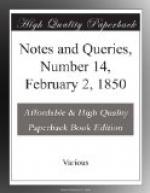1. What became of the natural child of Elizabeth Barry, the actress, who died 1713; and whether the Earl of Rochester, its father, was really Wilmot (as Galt assumes) or Hyde, on whom that title was conferred at Wilmot’s death? The former mentions a natural daughter in his last will; but he names it “Elizabeth Clerke,” and does not allude to its mother. Mrs. Barry’s will mentions no kindred whatever. But Galt describes her as daughter of Edward Barry, Esq., a barrister of Charles I.’s reign.—Who was he? Spranger Barry, the actor of fifty years later, Sir William Betham and myself have succeeded in connecting satisfactorily, and legitimately, with the noble house of Barry, Lord Santry; but I cannot as yet show that Mrs. E. Barry inherited her theatrical talent from an identical source.
2. Of what family was Mr. Barry, the Secretary to the Equivalent Company, who died about 1738? I possess immense collections on the name of Barry, but I cannot identify any London will or administration as this individual’s.
3. Whether Sir Robert Walpole’s Secret Government Lists of the Pretender’s adherents, agents, and emissaries in London (who were supposed to be under the evil-eye of Jonathan Wild) still exist, and are accessible?
WILLIAM D’OYLY BAYLEY.
Coatham, Yorkshire, Jan. 1849-50.
* * * * *
NINE QUERIES.
1. Book-plate.—Whose was the book-plate with the following device:—An eagle or vulture feeding with a snake another bird nearly as large as herself; a landscape, with the sea, &c. in the distance: very meanly engraved, in an oval, compassed with the motto, “Pietas homini tutissima virtus”?
2. Addison’s Books.—I have two or three volumes, bound apparently at the beginning of {213} the last century, with a stamp on the cover, consisting of J.A., in a cursive character, within a small circle. Was this the book-stamp of Joseph Addison?
3. Viridis Vallis.—Where was the monastery of “Viridis Vallis,” and what is its vernacular name?
4. Cosmopoli.—Has Cosmopoli been ever appropriated to any known locality? Archdeacon Cotton mentions it among the pseudonymes in his Typographical Gazetteer. The work whose real locality I wish to ascertain is, Sandii Paradox. iv. Evang. 1670. 1 vol. 8vo.
5. Seriopoli.—The same information is wanting respecting “Seriopoli; apud Entrapelios Impensis Catonis Uticensis:” which occurs in the title-page of “Seria de Jocis,” one of the tracts connected with the Bollandist controversy.
6. Early Edition of the Vulgate.—Where is there any critical notice of a very beautiful edition of the Vultage, small 4to., entitled “Sacra Biblia, cum studiis ac diligentia emendata;” in the colophon, “Venetiis, apud Jolitos, 1588”? The preface is by “Johannes Jolitus de Ferrarues.” The book is full of curious wood-cuts. This is not the book mentioned in Masch’s Le Long (part ii, p. 229), though that was also printed by the Gioliti in 1588; as the title of the latter book is “Biblia ad vetustissima Exemplaria castigata,” and the preface is by Hentenius.




